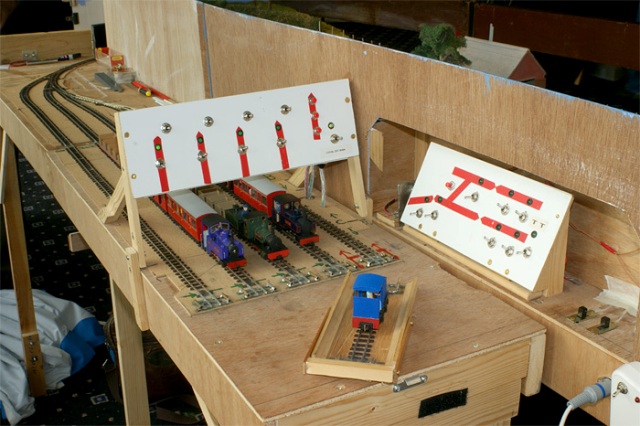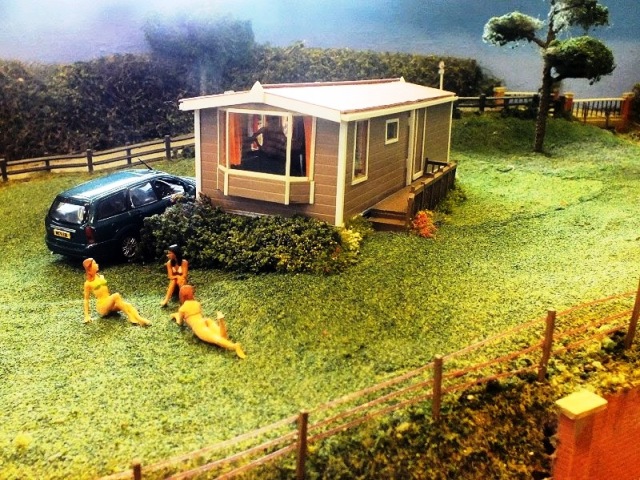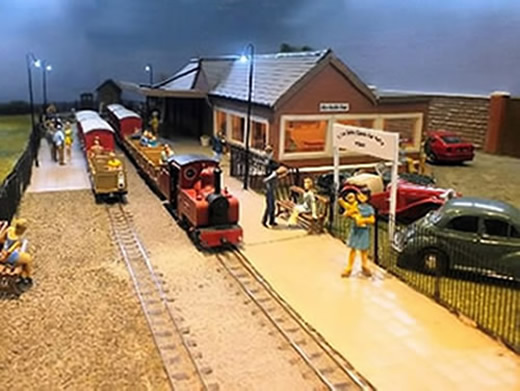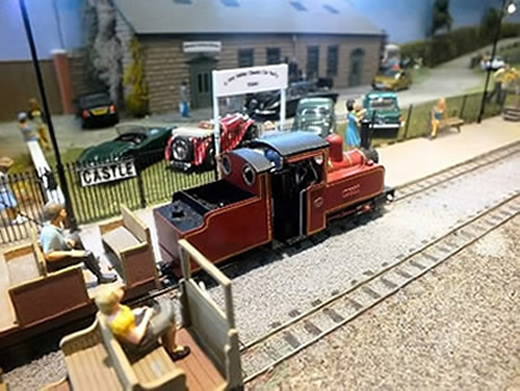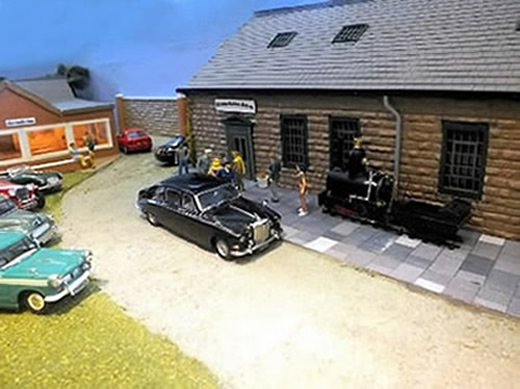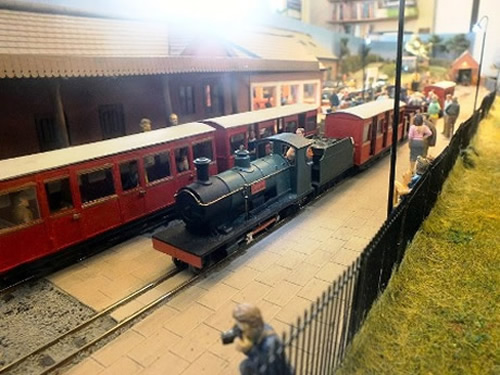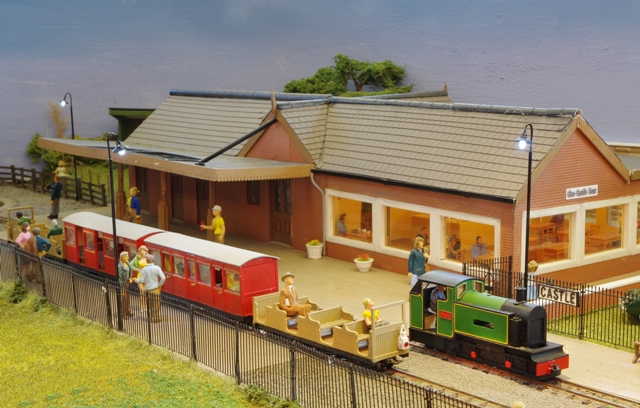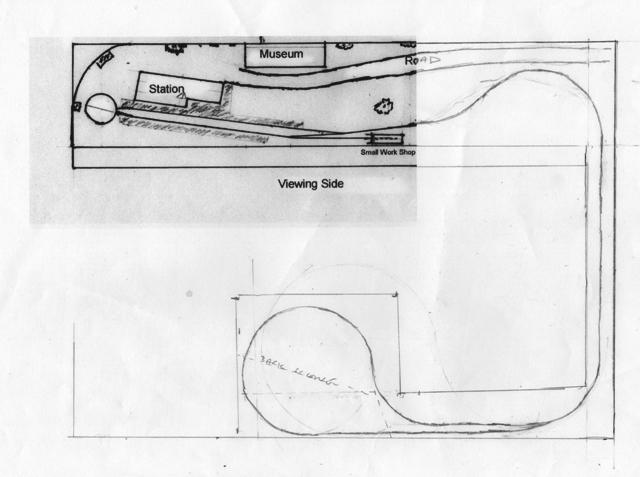Clee Valley Railway
Scale 7mm/ft: Gauge 9mm (09).
Having an interest in 15inch gauge miniature/minimum gauge railways it seemed that a reasonable step forward in my layout building would be a layout that represented this type of railway. There are 38 of these 15inch gauge railways in the UK so plenty of prototypes to use as a basis. However, rather than try to emulate a particular railway, I am involved with the Cleethorpes Coast Light Railway so I could have started there, I have used my imagination to come up with a ‘what if’ concept for this layout.
The name; ‘Clee Valley Railway’, came from using parts of the Cleethorpes Coast Light Railway and the Bure Valley Railway, however it was pointed out to me that the ‘Clee Hills’ are in Shropshire so the layout could be based in that area. Looking at a map it did seem feasible that a miniature railway could run from Craven Arms Railway Station to Stokesay Castle using somewhere between the 125 or 115 contour lines. OK it would run through a number of back gardens, the odd kitchen or two and perhaps somebody’s lounge, but! This idea led to the station on the layout being called ‘CASTLE’.
'Castle' station on the Clee Valley Railway
Models of miniature railways are not a new concept; with a number having been exhibited at Shows. So I was not really going into totally new territory, having been impressed with what I had seen, especially a layout called ‘Shifting Sands’ built by Colin Peake, I decided to ‘give it a go’ as a step up from 4mm/ft, with my 009 layouts to 7mm/ft with an 09 layout. As it was to be a tourist attraction, as I am not that keen on 1930s shunting planks, it was to be based in the early part of the 21st Century; probably about 2004/05. This partially set by the fact that I had a 1:43 scale Rover 75 with a ‘54’ plate. This does mean that the various structures and general scenery had to reflect this era. While much of the rolling stock used on the real miniature railways is quite old; although there are a number of new steam locomotives active on a number of lines, the methods of operation tend to be 21st century by using radios and mobile phones with much support through the internet. This meant that I did not have to worry about fitting signals to the layout. The planning of the actual layout was done using my usual method of scribbling some ideas on odd bits of paper to get a rough plan and then actually building the baseboards before any thoughts of fitting the track etc was considered. The purist amongst you will now, no doubt, turn to a different page. But my method, while perhaps unconventional, does actually work!
An overview of the layout
The constraints for the layout are simple. It must fit into my model railway workshop when fully assembled and working. So the overall size is limited to 10ft 6ins (3.2M) by 3ft (0.91M) For exhibitions I work on 12ft (3.7M) by the 3ft (1m) plus operator space; mainly for access. The layout must also be able to fit into my car. Along with all the other paraphernalia that is needed for a model railway show. So the first job was to build the baseboards for the layout. There are 5 boards in total. The main 3 scenery boards are each 40inches long by 24inches wide. The two fiddle yard boards are 34inches long by 12inches wide. The boards are constructed in the well tested method of 6mm plywood tops, PSE timber for the frames with 9mm by 4inch plywood longitudinal supports. Support legs are hinged from the frames and fold behind the ply longitudinal supports so that they cannot be forgotten. This, I find, gives a very strong but relatively light baseboard. The boards are joined together using 6mm setscrews with captive T nuts and located with brass dowels. Once the boards were up in the workshop planning of the track layout could commence in earnest. The track layout is based loosely on Wroxham (Hoveton) on the Bure Valley Railway; the main station is also based on the one at this location with the addition of a refreshment area. To ensure that the tracks would line up correctly the first item to fit was the turntable. This is a Peco ‘N’ gauge unit, acquired second hand, and modified to make it look less ‘N’ gauge. The tracks from the turntable could then be laid. The track is glued onto 1/16th inch cork with impact adhesive. The cork, which is in strips just wider than the track sleepers, had previously been glued, with PVA, to the baseboard. This gives a small shoulder to the track bed. The entire remaining track was then laid in the same manor following the ‘back of an envelope’ sketch. Hopefully the track plan produced here makes the general layout clear.
 copyw.jpg)
The layout is split into 19 sections, some controlled by switches and others by the points. Or at least the switches fitted to the point motors. Blade contact is not really acceptable for reliable running. The two points on the scenic section are operated by wire in the tube with the polarity switched by slide switches, the points in the fiddle yard are operated by Seep point motors, with passing contact switches fitted to a control panel above the rails. This panel also contains switches for the track sections in the fiddle yard. This fiddle yard has five tracks, four are for the rakes of coaches and the fifth is the release track so that the locos can be moved to the other end of the coach rakes without them being handled. The locos are turned by the use of a small cassette. The control of the scenic section is from a small panel fitted behind the ‘museum’ building on board 2 with each of the section switches coupled to an LED to show which sections are live. There are five rakes of coaches and up to 8 locos in operation when the layout is in use. Operation is, in fact fairly simple; the first train of the day is sent from the fiddle yard to ‘CASTLE’ station. The loco uncouples with the uncoupling magnet set into the track and goes onto the turntable. It is turned and then runs round to the other end of the train, re couples and then waits. The next train is then despatched from the fiddle yard to the station. It is a single track line between the station and the fiddle yard, when it arrives at the second platform the first train can leave for the fiddle yard. The loco on the second train is uncoupled, is turned and runs round to the front of the train and awaits the next train to arrive. This then continues throughout the running session. Sometimes an additional loco is kept in the Shed at the front of the layout so engines can be changed at the 'Castle' end of the layout rather than just in the fiddle yard. But, yes there is always a ‘but’. When the trains arrive back at the fiddle yard the locos have to be uncoupled, again by uncoupling magnets set in the track, turned and made ready to couple onto a train in preparation for another movement from the fiddle yard to the station. This is done by the use of the cassette and the loco release track. The release track can hold 4 locos, just, so each loco is used in turn and the loco that brought the train into the fiddle yard will not take it back out towards the station. This does mean that the operator does need to be on the ball otherwise you will have four trains in the fiddle yard all with the locos on the wrong end!
The scenery follows the normal practice of polystyrene, Mod-roc and plaster mixed with brown paint, suitably covered with various scatters to form the desired surface finishes. Trees are made from twisted florist wire, Green Scene Flexi-bark and again various scatter materials. All the buildings, apart from the small hut by the turntable, are scratch built using thick plastic and suitably embossed plastic card. The station is loosely based on the Bure Valley building at Hoveton (Wroxham) with the static caravan based on one of those made by Swift Caravans of Cottingham in East Yorkshire. Figures are from Preiser and Oman miniatures, most purchased unpainted and as well as being posed in groups they have also been used to supply passengers for the trains. The coaching stock is from Avalon and Chivers kits plus three scratch built by Colin Peake. Other stock from Miniature Gauge Models and ek3d Printing is under construction and will appear on the layout at some time.
The caravan is based on one of the models from Swift Caravans in East Yorkshire
The motive power is a varied mix of scratch and kit built items as follows:
'Rebecca' a TMA BO-BO diesel using a 3d print body by Derek Smith from i.materialise, fitted
with a TM-08R Tomytec chassis. The paint job is by Ken Gibbons
A small diesel, as yet un-named from a ‘mite’ kit, on a Bachmann chassis.
Another diesel from the A1 kit on a Kato chassis.
A 3D printed RH&DR PW3 diesel.
An A1 Lister diesel.Other loco kits are under construction and will make an appearance at some time.
This shows the work is progressing on a new diesel based on the Romney, Hythe & Dymchurch Railway TMA Engineering types Nos 12 & 14. Shown here on the layout, but with the caravan removed, hauling a short train. The loco is still in 'pink primer' at this stage. It will be painted red and given a name so will belong to the CVR rather than being on loan from the RH&DR.
The loco with the finished paint job. Now needs name/number horn!
All the locos are powered by ‘N’ gauge chassis of various types.
So a rather eclectic model railway that, in real life would have been run and maintained by volunteers as are most of the miniature railways in the UK. Without the encouragement of fellow members of the Hull Miniature Railway Society, none of whom model in this scale/ gauge, this layout would not have been built. Thanks also to Paul Windle, Ken Gibbons, Colin Peake and the various model railway Show Managers who have taken the risk and had the layout at their shows.
The following images of the layout were taken by Mick Thornton at the 25th, and last, Narrow Gauge South West Show in 2017. They are reproduced here with the kind permission of Mick, AKA the 'Roving Reporter'.
Janette arriving with a train
This layout appeared at the following Model Railway Shows:
2013: Hull.
2014: Small & Delightful Show; Shepton Mallet.
2014: Narrow Gauge North; Leeds.
2014: York.
2014: Porthmadog.
2014: Barrow Hill Live.
2014: Warley National Exhibition; Birmingham.
2015: Lincoln.
2015: Cleethorpes.
2015: 7mmNGA Convention; Burton-upon-Trent.
2015: Boston
2015: Caistorail; Castor.
2016: Normanton & Pontefract.
2016: Selby.
2016: Holmfirth (Huddersfield).
2016: Hull.
2017: Shepton Mallet (S&D).
2017: Preston.
2017: Nottingham
2017: Apedale Show
2018: Barrow in Furness
2019: York
The Future:
As both the layout and the operators suffered from Heat Stroke at the 2019 York Show It has been decided that the layout will be converted to a fixed 'home based' layout starting in the Autumn. As the layout has done 22 Shows it has had a good run.
I will keep the web site updated with progress, there could be some more stock being available to the line soon.
October 2019 The new open coach based on the RH&DR Aluminium 20 seat open coach |
The open coach & the 2 Clayton Pullmans. Train now needs a 20 seat Saloon (under construction) |
The RH&DR rake complete with the 20 seat saloon ready to leave Castle station
Work has started on modifying the layout to become a fixture at home. Not a lot of progress yet but the control panel has been moved,
